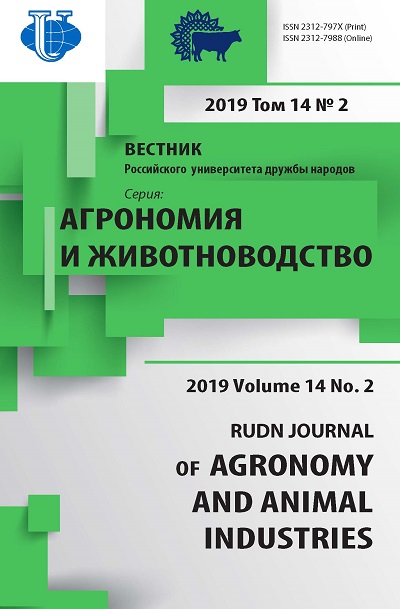The efficiency of use lentiviral vectors for the transformation of rooster spermatogenic cells in vivo
- Authors: Volkova N.A.1, Vetokh A.N.1, Volkova L.A.1, Nataliya A.Z.1
-
Affiliations:
- Federal Science Center for Animal Husbandry named after Academy Member L.K. Ernst
- Issue: Vol 14, No 2 (2019)
- Pages: 162-169
- Section: Veterinary science
- URL: https://agrojournal.rudn.ru/agronomy/article/view/19494
- DOI: https://doi.org/10.22363/2312-797X-2019-14-2-162-169
- ID: 19494
Cite item
Full Text
Abstract
Male gonad cells are considered as promising target cells for the introduction of recombinant DNA within obtaining genetically modified individuals with given characteristics. The use of testicular spermatogonial stem cells is of the greatest interest. In the process of differentiation, this type of cell gives rise to a significant population of mature male germ cells. In the case of their genetic transformation, differentiated cells can be used to inseminate females in order to produce transgenic progeny. The aim of the research was to study the efficiency of using lentiviral vectors for the local transformation of roosters’ testicular spermatogenic cells. We used a lentiviral vector containing the ZsGreen reporter gene under the control of the CMV promoter. In vitro transformation of rooster spermatogenic cells was carried out by infection with a viral preparation, in vivo through multiple injections of the viral preparation into the testicular parenchyma of roosters ( n = 5). The efficiency of transformation was assessed by expression of the reporter ZsGreen gene in transfected spermatogenic cells. The success of using lentiviral vectors for the genetic transformation of rooster spermatogenic cells was shown in experiments in vitro and in vivo . The transformation efficiency of this cells types in an in vitro culture varied from 45 to 57% and averaged 48 ± 4%. The expression of the ZsGreen reporter gene in the cells of the spermatogenic epithelium of the testes was established in almost all experimental roosters in the in vivo experiments. The number of seminiferous tubules with transformed spermatogenic cells varied in the studied experimental roosters from 10 to 22%. The effectiveness of genetic transformation of the testes spermatogenic cells was 1.8 ± 0.2%. The obtained results indicate to the success of using lentiviral vectors for the genetic transformation of spermatogenic cells of rooster testes in vivo in order to create individuals with genetically transformed germ cells for the further production of transgenic offspring with given characteristics.
About the authors
Natalya Alexandrovna Volkova
Federal Science Center for Animal Husbandry named after Academy Member L.K. Ernst
Author for correspondence.
Email: natavolkova@inbox.ru
Doctor of Sciences in Biology, Professor of the Russian Academy of Sciences, Head of the Laboratory of Cell Engineering
Moscow region, Russian FederationAnastasia Nikolaevna Vetokh
Federal Science Center for Animal Husbandry named after Academy Member L.K. Ernst
Email: anastezuya@mail.ru
Researcher of the Laboratory of Functional and Evolutionary Genomics of Animals
Moscow region, Russian FederationLyudmila Aleksandrovna Volkova
Federal Science Center for Animal Husbandry named after Academy Member L.K. Ernst
Email: ludavolkova@inbox.ru
Candidate of Sciences in Biology, Senior Researcher of the Laboratory of Cell Engineering
Moscow region, Russian FederationAnatolievna Zinovyeva Nataliya
Federal Science Center for Animal Husbandry named after Academy Member L.K. Ernst
Email: n_zinovieva@mail.ru
Doctor of Sciences in Biology, Academician of the Russian Academy of Sciences
Moscow region, Russian FederationReferences
- Brinster RL. Germline stem cell transplantation and transgenesis. Science. 2002; 296(5576): 2174—2176. Available from: doi: 10.1126/science.1071607.
- Zheng Y, Zhang Y, Qu R, He Y, Tian X, Zeng W. Spermatogonial stem cells from domestic animals: Progress and prospects. Reproduction. 2014; 147(3):R65—R74. Available from: doi: 10.1530/REP-13-0466.
- Spadafora C. Sperm cells and foreign DNA: a controversial relation. Bioassays. 1998; 20(11):955—964. Available from: doi: 10.1002/(SICI)1521-1878(199811)20:11<955::AID-BIES11>3.0.CO;2-8.
- McLean DJ. Spermatogonial stem cell transplantation and testicular function. Cell Tissue Research. 2005; 322(1):21—31. Available from: doi: 10.1007/s00441-005-0009-z.
- Brinster RL, Nagano M. Spermatogonial stem cell transplantation, cryopreservation and culture. Seminars in Cell & Developmental Biology. 1998; 9(4):401—409. Available from: doi: 10.1006/scdb.1998.0205.
- De Rooij DE, Griswold MD. Questions about spermatogonia posed and answered since 2000. Journal of andrology. 2012; 33(6):1085—1095. Available from: doi: 10.2164/jandrol.112.016832.
- Bykova VL, Zhunkeira LK, Karneiro Zh. (eds). Histology: atlas, study guide. Мoscow: GEOTAR Media Publ.; 2009. (In Russ).
- Yu F, Ding LJ, Sun GB, Sun PX, He XH, Ni LG, Li BC. Transgenic sperm produced by electrotransfection and allogeneic transplantation of chicken fetal spermatogonial stem cells. Molecular Reproduction and Development: Incorporating Gamete Research. 2010; 77(4):340—347. Available from: doi: 10.1002/mrd.21147.
- Oatley JM. Spermatogonial stem cell biology in the bull: development of isolation, culture, and transplantation methodologies and their potential impacts on cattle production. Reprod. Domest. Rumin. 2010; 67(7):133—143.
- Savchenkova IP, Korzhikova SV, Kostereva NV, Ernst LK. Cultivation and transplantation of boar type A spermatogonia. Ontogenesis. 2006; 37(4):292—300. (In Russ).
- Novgorodova IP, Mormyshev AN, Volkova NA, Zinovieva NA, Ernst LK. Genetic transformation of rabbit spermatogonium in vivo. Biotechnology. 2008; (1):24—28. (In Russ).
- Volkova N.A., Zinovieva N.A., Volkova L.A., Lotsmanova N.S., Ernst L.K. Study of factors affected the efficiency of gene transfer into the male germ cells of agricultural animals. Agricultural Biology. 2010; 45(6):16—19. (In Russ).
- Beloglazova EV, Kotova TO, Volkova NA, Volkova LA, Zinovieva NA, Ernst LK. Age dynamics of spermatogenesis in cocks in connection with optimization of bioengineering manipulation time. Agricultural Biology. 2011; 46(6):60—64. (In Russ).
Supplementary files















